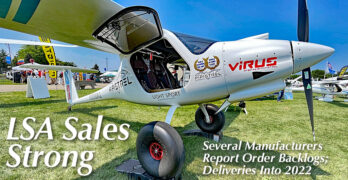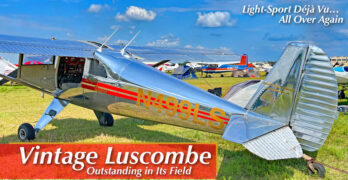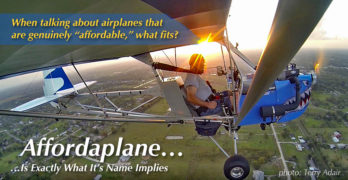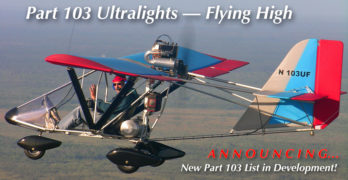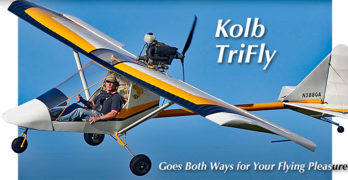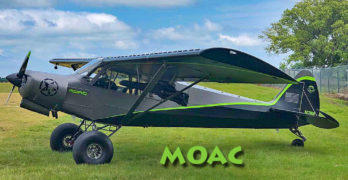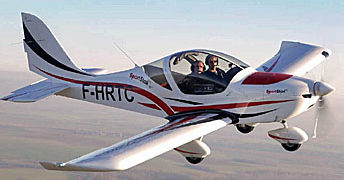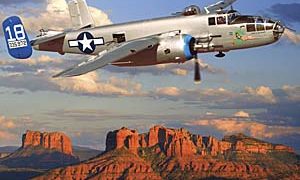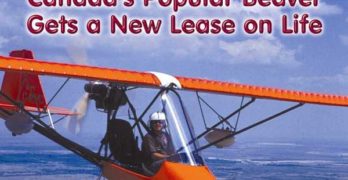Day 2 AirVenture began with “rain that went sideways,” according to one vendor. After a late night cranking out a report, I was grateful for an excuse to get another hour’s sleep. The overnight rain gave way to another beautiful, if hot, day in Oshkosh.
Tuesday, I hiked up to the north side, where the main displays are located. Most of the higher end Light-Sport Aircraft are located in this high-traffic area. Several LSA companies have jockeyed for years to find what they consider to be the optimal location for their exhibit. Being near the main foot-traffic road is very alluring to vendors.
In almost two decades of Light-Sport Aircraft (the then-new rule was announced at AirVenture 2004), LSA have integrated themselves into mainstream aircraft manufacturing …and not simply because of the aircraft offered. As late-night TV ads once said, “There’s more!”
LAMA board of directors member Phil Solomon — active in the flight school business and a former importer of Tecnam — expressed that the sales of LSA and the growth and development of the industry is only one of its successes.
Search Results for : Vintage Ultralights
Not finding exactly what you expected? Try our advanced search option.
Select a manufacturer to go straight to all our content about that manufacturer.
Select an aircraft model to go straight to all our content about that model.
Sun ‘n Fun 2021 / Reflections… Skyleader, Luscombe, Rev XS Winner
Continuing news from Sun ‘n Fun 2021 is rolling in from across the country. Even while most international enthusiasts were unable to attend because of covid-induced travel restrictions, Americans turned out in strong numbers — and had a great time.
FAA personnel casually (not officially) reported some 70,000 tickets bought on Saturday alone. I have no idea about such numbers historically, but by any measure, that’s a darn fine performance, the equivalent of a major football stadium stuffed full of fans. I am so relieved for Sun ‘n Fun. Inc., and I’m sure my relief is but a drop in the bucket compared to that felt by Team Sun ‘n Fun.
If Oshkosh goes similarly, then I think it will be fair to say recreational aviation is nearly back to normal. Fortunately, in the Year of Fear that may be ending, tons of builders worked on kit airplanes, loads of LSA owners got out and flew their birds, and Part 103 ultralights probably set a record for shipments and kept sport pilots up in the air.
Does Affordable Aviation Interest You? Then You Should Learn About Affordaplane
This website promotes a focus on affordable aviation, but the word “affordable” means different things to different people at different times.
For some “affordable” may include Special LSA selling for more than $200,000. After all, that’s a fraction of a loaded Cirrus SR22, for example. For others, even $20,000 is more than they wish to spend.
Fortunately, you have a wide variety of choices. Our April 2020 series was composed of ten articles about used light aircraft you can buy for less than $10,000.
We also continue work on our Part 103 list. From the current count of 57 producers, most have choices that are affordable to most pilots plus you get the benefit of almost no regulatory authority over your flying activity (no pilot certificate, no N-numbers, no medical, plus you can buy ready to fly and maintain any way you wish).
So, Now…
Affordaplane
Any design so named seems to fit our mission perfectly.
How To Account for Growing Part 103 Ultralight Sales? Here’s My Plan (But Please Help!)
Pilots around the world are aware of Part 103 Ultralights but many have a blurry view of the industry that produces these aircraft. Most are unaware how well this often-overlooked segment is doing in recent years, even during Covid 2020.
FAA refers to these lightweight flying machines as “ultralight vehicles,” a term that creative rulewriters adopted in the early 1980s to avoid heavy regulations typical for “aircraft.” This wording helped the young industry grow and develop. It worked so well the regulation has not been altered for decades.
Even ultralight enthusiasts in America and other countries may not be fully aware how popular ultralights have become in recent years. When Light-Sport Aircraft came on the scene in 2004 they knocked out the ultralight two-seater training fleet. Many believe ultralights never recovered.
How wrong they were, yet who can blame them because no one truly knows how many ultralights are being built and sold these days.
Try and Fly TriFly — Kolb’s Wonderful Single Seat Light Aircraft Goes Both Ways
Some pilots are wary of taildraggers. This is hardly surprising since only tricycle-gear aircraft have been used in primary flight instruction dating back into the 1970s. Most pilot have no experience with taildraggers but nearly all have heard of the dreaded ground-loop tendency such gear configuration can allow.
Indeed, when investigating insurance for a taildragger, you will have to prove you have some experience or get training from a suitably-experienced instructor — and you won’t find many able to help you.
How about if an aircraft went both ways? What if an affordable aircraft allowed you to fly with tricycle gear but permitted you to practice your taildragger technique yet still use the nosewheel’s self-straightening capability if you start to get a little “sideways” (literally or figuratively)?
Kolb Aircraft has an answer.
Kolb TriFly
Producers of Part 103 aircraft, such as Kolb Aircraft report consistently strong business for the last few years.
Sun ‘n Fun Day 5 …Wrap Up — Cub and Mother; Sopwith Camel Replica, Father of Ultralight Aircraft
Sun ‘n Fun is over. While staff, tent vendors and more have plenty of work to do, customers and vendors have all vacated the area, scattering off across the USA as they return to base.
Some have a new airplane. Numerous vendors reported solid sales during the show. Pilots liked what they saw and a good economy is powering activity. I will follow up with a show summary soon.
Following I have three more short stories. However, watch for dozens of new videos from Light Sport and Ultralight Flyer on YouTube and I will have further reporting from material gathered at Sun ‘n Fun 2019.
MOAC — “Tweety” got mine and lots of well-deserved attention (photo), being the very first airplane American Legend produced, back in 2005. The original aircraft was on display at Sun ‘n Fun. Since the company has since registered 226 aircraft, Tweety launched quite a good run.
Evektor with Dynon Earns EASA Type Certificate
The very first aircraft ever to receive approval in the USA as a Light-Sport Aircraft is Evektor-Aerotechnik’s SportStar. No challenger can ever take away that title yet the company has continually developed this pioneeering airplane and recently achieved a new level of approval … one that alters the landscape in a way I predict we’ll see more as FAA’s Part 23 rewrite project progresses. “Following several months of certification process EASA has approved glass cockpit Dynon SkyView [as] SportStar RTC,” Evektor announced. RTC stands for Restricted Type Certificate. It is not identical the U.S. Part 23 Type Certificate — representing a somewhat lower level of government oversight — but a company earning this has to jump through many regulatory hoops. “SportStar RTC has become the first EASA certified aircraft approved with the SkyView glass cockpit [by proving] compliance with certification requirements of the EASA CS-LSA regulations. Dynon’s SkyView, recently upgraded to permit touch functionality, is widely known and used on Light-Sport Aircraft.
Copperstate 2010 Is Coming Next
During my recent appearance on the Powered Sport Flying (Internet) Radio Show, I said I remained amazed that although the western U.S. has a large share of all pilots and airplanes in the country, no western airshow seems to have taken off the way Sun ‘n Fun or AirVenture has. True enough, no west-of-the-Mississippi event comes close in size to the eastern shows, but my comments weren’t fair to steady work by organizers of Copperstate, an event with a 37-year history (nor to the even-larger and older Arlington show or the Golden West event.) These western shows may not be huge, but they reveal an aviation passion. *** This year’s Copperstate will be held in Casa Grande, Arizona — just south of Phoenix — from Thursday, October 21st through Saturday, October 23rd. The 2009 edition reported “more than 6,500 attendees.” I spoke with new LSA enthusiast Steve Bass, Copperstate Fly-In Vice President and Light Sport & Ultralight Committee Chairman.
Judging Winners Sun ‘n Fun 2010
I once followed judging at shows like AirVenture and Sun ‘n Fun. In fact, an aircraft I helped inspire — a modernized primary glider called the SuperFloater — won Outstanding New Design at Sun ‘n Fun 1995. Judges closely examined homebuilts, kit or restored vintage airplanes, and warbirds. If they included factory built aircraft, I was not aware of it. *** So, this year I admitted surprise after learning factory-built Light-Sport Aircraft won awards. *** To honor the hundreds or thousands of hours people put into their winners, I want to highlight some LSA and ultralights that judges liked. The Grand Champion LSA was Wayne Spring’s 2010 Predator powered parachute; Reserve Grand Champ was James Jonannes’ 2009 Arion Lightning LS-1; Grand Champion Ultralight was James Wiebe’s 2010 Belite Superlite; and, Reserve Grand Champ was Danny Dezauche’s 2010 CGS Hawk Ultra.
Beaver RX-550
Perhaps the most famous ultralight to come out of Canada is the Beaver. With a reported 2,200 units flying since the early 1980s, this is one of the most successful light aircraft ever. However, due to missteps by companies that previously manufactured the brand, this popular ultralight was nearly lost from the ultralight aviation landscape. Were it not for the Aircraft Sales and Parts (ASAP) company and the Holomis family, you might not have this choice today.
Originally the Beaver RX-550 came from a company called Spectrum Aircraft. A company reorganization left the ultralight in the hands of a company named Beaver RX Enterprises. Both these business names disappeared and today the ASAP brand carries the Beaver into the sky.
In 1993, a couple years after our last report on the Beaver1, the old company closed its doors and effectively stranded thousands of Beaver ultralight owners and all the dealerships that sold them.


